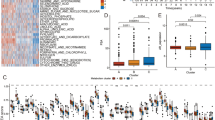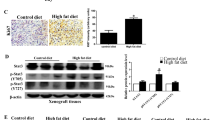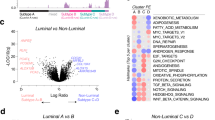Abstract
The goal of this study was to evaluate prostate cancer gene expression signatures associated with elevated body mass index (BMI). Global gene expression profiles of prostate tumor cells and matching normal epithelial cells were compared between patients with features of normal and high BMI at the time of radical prostatectomy. Knowledge-based analyses revealed an association of high BMI with altered levels of lipid metabolism and cholesterol homeostasis genes, such as stearoyl-CoA desaturase 1 (SCD1) and insulin-induced gene 1 (INSIG1), respectively, in prostate tumor cells. These genes were connected to known pathways of tumorigenesis revealed by the v-maf (musculoaponeurotic fibrosarcoma) oncogene homolog (MAF), notch receptor ligand, jagged 1 (JAG1) and the alanyl aminopeptidase (ANPEP/CD13) genes. This study highlighted that SCD1, a known target of statins, may have a mechanistic role in the recently noted beneficial effects of statin treatment in reducing biochemical recurrence of prostate cancer. An additional finding of our study is that some of the obesity-related genes were upregulated in tumor-matched normal cells within the high BMI group, when compared with normal cells within the normal BMI cohort.
This is a preview of subscription content, access via your institution
Access options
Subscribe to this journal
Receive 4 print issues and online access
$259.00 per year
only $64.75 per issue
Buy this article
- Purchase on Springer Link
- Instant access to full article PDF
Prices may be subject to local taxes which are calculated during checkout




Similar content being viewed by others
References
Moul JW, Sesterhenn IA, Connelly RR, Douglas T, Srivastava S, Mostofi FK et al. Prostate-specific antigen values at the time of prostate cancer diagnosis in African-American men. JAMA 1995; 274: 1277–1281.
Schaid DJ . The complex genetic epidemiology of prostate cancer. Hum Mol Genet 2004; 13: 103–121.
Witte JS . Prostate cancer genomics: towards a new understanding. Nat Rev Genet 2009; 10: 77–82.
Zadra G, Priolo C, Patnaik A, Loda M . New strategies in prostate cancer: targeting lipogenic pathways and the energy sensor AMPK. Clin Cancer Res 2010; 16: 3322–3328.
Hankey BF, Feuer EJ, Clegg LX, Hayes RB, Legler JM, Prorok PC et al. Cancer surveillance series: interpreting trends in prostate cancer--part I: Evidence of the effects of screening in recent prostate cancer incidence, mortality, and survival rates. J Natl Cancer Inst 1999; 91: 1017–1024.
Coffey RN, Watson RW, Fitzpatrick JM . Signaling for the caspases: their role in prostate cell apoptosis. J Urol 2001; 165: 5–14.
Coffey DS . New insights and methodologies are needed to solve the many epidemiologic enigmas of prostate cancer. Epidemiol Rev 2001; 23: 1.
Freedland SJ, Williams CD, Masko EM . Adiponectin and prostate cancer mortality: to be or not to be skinny? Clin Chem 2010; 56: 1–3.
Freedland SJ, Platz EA . Obesity and prostate cancer: making sense out of apparently conflicting data. Epidemiol Rev 2007; 29: 88–97.
Davies BJ, Smaldone MC, Sadetsky N, Dall’era M, Carroll PR . The impact of obesity on overall and cancer specific survival in men with prostate cancer. J Urol 2009; 182: 112–117; discussion 117.
Michalakis K, Williams CJ, Mitsiades N, Blakeman J, Balafouta-Tselenis S, Giannopoulos A et al. Serum adiponectin concentrations and tissue expression of adiponectin receptors are reduced in patients with prostate cancer: a case control study. Cancer Epidemiol Biomarkers Prev 2007; 16: 308–313.
Li H, Stampfer MJ, Mucci L, Rifai N, Qiu W, Kurth T et al. A 25-year prospective study of plasma adiponectin and leptin concentrations and prostate cancer risk and survival. Clin Chem 2010; 56: 34–43.
Freedland SJ . Obesity and prostate cancer: a growing problem. Clin Cancer Res 2005; 11: 6763–6766.
Nobes JP, Langley SE, Laing RW . Metabolic syndrome and prostate cancer: a review. Clin Oncol (R Coll Radiol) 2009; 21: 183–191.
Murtola TJ, Tammela TL, Maattanen L, Huhtala H, Platz EA, Ala-Opas M et al. Prostate cancer and PSA among statin users in the Finnish prostate cancer screening trial. Int J Cancer 2010; 127: 1650–1659.
Getzenberg RH . Statins and the risk of prostate cancer or benign prostatic hyperplasia: biological plausibility. J Urol 2010; 184: 415–416.
Zhuang L, Kim J, Adam RM, Solomon KR, Freeman MR . Cholesterol targeting alters lipid raft composition and cell survival in prostate cancer cells and xenografts. J Clin Invest 2005; 115: 959–968.
Sekine Y, Furuya Y, Nishii M, Koike H, Matsui H, Suzuki K . Simvastatin inhibits the proliferation of human prostate cancer PC-3 cells via down-regulation of the insulin-like growth factor 1 receptor. Biochem Biophys Res Commun 2008; 372: 356–361.
Banez LL, Klink JC, Jayachandran J, Lark AL, Gerber L, Hamilton RJ et al. Association between statins and prostate tumor inflammatory infiltrate in men undergoing radical prostatectomy. Cancer Epidemiol Biomarkers Prev 2010; 19: 722–728.
Hamilton RJ, Banez LL, Aronson WJ, Terris MK, Platz EA, Kane CJ et al. Statin medication use and the risk of biochemical recurrence after radical prostatectomy: results from the Shared Equal Access Regional Cancer Hospital (SEARCH) Database. Cancer 2010; 116: 3389–3398.
Hirsch HA, Iliopoulos D, Joshi A, Zhang Y, Jaeger SA, Bulyk M et al. A transcriptional signature and common gene networks link cancer with lipid metabolism and diverse human diseases. Cancer Cell 2010; 17: 348–361.
Centers for Disease Control and Prevention. Overweight and Obesity. US Obesity Trends. www.cdc.gov/obesity/data/trends.html. (accessed 11 Aug 2010).
Giovannucci E, Rimm EB, Stampfer MJ, Colditz GA, Willett WC . Height, body weight, and risk of prostate cancer. Cancer Epidemiol Biomarkers Prev 1997; 6: 557–563.
Okasha M, McCarron P, McEwen J, Smith GD . Body mass index in young adulthood and cancer mortality: a retrospective cohort study. J Epidemiol Community Health 2002; 56: 780–784.
Burton A, Martin R, Galobardes B, Davey Smith G, Jeffreys M . Young adulthood body mass index and risk of cancer in later adulthood: historical cohort study. Cancer Causes Control 2010; doi:10.1007/s10552-010-9625-3.
Furusato B, Shaheduzzaman S, Petrovics G, Dobi A, Seifert M, Ravindranath L et al. Transcriptome analyses of benign and malignant prostate epithelial cells in formalin-fixed paraffin-embedded whole-mounted radical prostatectomy specimens. Prostate Cancer Prostatic Dis 2008; 11: 194–197.
Sun C, Dobi A, Mohamed A, Li H, Thangapazham RL, Furusato B et al. TMPRSS2-ERG fusion, a common genomic alteration in prostate cancer activates C-MYC and abrogates prostate epithelial differentiation. Oncogene 2008; 27: 5348–5353.
Petrovics G, Liu A, Shaheduzzaman S, Furusato B, Sun C, Chen Y et al. Frequent overexpression of ETS-related gene-1 (ERG1) in prostate cancer transcriptome. Oncogene 2005; 24: 3847–3852.
Cohen CD, Lindenmeyer MT, Eichinger F, Hahn A, Seifert M, Moll AG et al. Improved elucidation of biological processes linked to diabetic nephropathy by single probe-based microarray data analysis. PLoS One 2008; 3: e2937.
Dennis Jr G, Sherman BT, Hosack DA, Yang J, Gao W, Lane HC et al. DAVID: Database for Annotation, Visualization, and Integrated Discovery. Genome Biol 2003; 4: P3.
Scherf M, Epple A, Werner T . The next generation of literature analysis: integration of genomic analysis into text mining. Brief Bioinform 2005; 6: 287–297.
Lee YH, Nair S, Rousseau E, Allison DB, Page GP, Tataranni PA et al. Microarray profiling of isolated abdominal subcutaneous adipocytes from obese vs non-obese Pima Indians: increased expression of inflammation-related genes. Diabetologia 2005; 48: 1776–1783.
Flowers MT, Ntambi JM . Stearoyl-CoA desaturase and its relation to high-carbohydrate diets and obesity. Biochim Biophys Acta 2009; 1791: 85–91.
Martin-Fuentes P, Garcia-Otin AL, Calvo L, Gomez-Coronado D, Civeira F, Cenarro A . Atorvastatin decreases stearoyl-CoA desaturase gene expression in THP-1 macrophages incubated with oxidized LDL. Lipids 2009; 44: 115–123.
Brown JM, Rudel LL . Stearoyl-coenzyme A desaturase 1 inhibition and the metabolic syndrome: considerations for future drug discovery. Curr Opin Lipidol 2010; 21: 192–197.
Fritz V, Benfodda Z, Rodier G, Henriquet C, Iborra F, Avances C et al. Abrogation of de novo lipogenesis by stearoyl-CoA desaturase 1 inhibition interferes with oncogenic signaling and blocks prostate cancer progression in mice. Mol Cancer Ther 2010; 9: 1740–1754.
Leong KG, Gao WQ . The Notch pathway in prostate development and cancer. Differentiation 2008; 76: 699–716.
Wang Z, Li Y, Banerjee S, Kong D, Ahmad A, Nogueira V et al. Down-regulation of Notch-1 and Jagged-1 inhibits prostate cancer cell growth, migration and invasion, and induces apoptosis via inactivation of Akt, mTOR, and NF-kappaB signaling pathways. J Cell Biochem 2010; 109: 726–736.
Santagata S, Demichelis F, Riva A, Varambally S, Hofer MD, Kutok JL et al. JAGGED1 expression is associated with prostate cancer metastasis and recurrence. Cancer Res 2004; 64: 6854–6857.
Liu AY, Roudier MP, True LD . Heterogeneity in primary and metastatic prostate cancer as defined by cell surface CD profile. Am J Pathol 2004; 165: 1543–1556.
Nguyen PL, Ma J, Chavarro JE, Freedman ML, Lis R, Fedele G et al. Fatty Acid Synthase Polymorphisms, Tumor Expression, Body Mass Index, Prostate Cancer Risk, and Survival. J Clin Oncol 2010; 28: 3958–3964.
Calle EE, Rodriguez C, Walker-Thurmond K, Thun MJ . Overweight, obesity, and mortality from cancer in a prospectively studied cohort of U.S. adults. N Engl J Med 2003; 348: 1625–1638.
Rodriguez C, Patel AV, Calle EE, Jacobs EJ, Chao A, Thun MJ . Body mass index, height, and prostate cancer mortality in two large cohorts of adult men in the United States. Cancer Epidemiol Biomarkers Prev 2001; 10: 345–353.
Mink SR, Hodge A, Agus DB, Jain A, Gross ME . Beta-2-microglobulin expression correlates with high-grade prostate cancer and specific defects in androgen signaling. Prostate 2010; 70: 1201–1210.
Neuhouser ML, Till C, Kristal A, Goodman P, Hoque A, Platz EA et al. Finasteride modifies the relation between serum C-peptide and prostate cancer risk: results from the Prostate Cancer Prevention Trial. Cancer Prev Res (Phila Pa) 2010; 3: 279–289.
Kaaks R, Stattin P . Obesity, endogenous hormone metabolism, and prostate cancer risk: a conundrum of ‘highs’ and ‘lows’. Cancer Prev Res (Phila Pa) 2010; 3: 259–262.
Gutt R, Tonlaar N, Kunnavakkam R, Karrison T, Weichselbaum RR, Liauw SL . Statin use and risk of prostate cancer recurrence in men treated with radiation therapy. J Clin Oncol 2010; 28: 2653–2659.
Platz EA, Leitzmann MF, Visvanathan K, Rimm EB, Stampfer MJ, Willett WC et al. Statin drugs and risk of advanced prostate cancer. J Natl Cancer Inst 2006; 98: 1819–1825.
Acknowledgements
We thank Ms Lakshmi Ravindranath and Ms London Toney for the superb technical assistance, Mr Zhe Chang and Ms Sally Elsamanoudi for the medical informatics support, Mr Stephen Doyle for the outstanding art work and Ms Tia Morris for editorial comments. This work was funded by the CPDR through an ongoing grant from the US Army Medical Research and Materiel Command and the NIH grant RO1 DK065977 to SS and GP.
Author information
Authors and Affiliations
Corresponding author
Ethics declarations
Competing interests
The authors declare no competing financial interests.
Additional information
Disclaimer
The views expressed in this manuscript are those of the authors and do not reflect the official policy of the Department of the Army, Department of Defense or the US Government. Released for publication by the WRAMC Public Affairs Office.
Rights and permissions
About this article
Cite this article
Sharad, S., Srivastava, A., Ravulapalli, S. et al. Prostate cancer gene expression signature of patients with high body mass index. Prostate Cancer Prostatic Dis 14, 22–29 (2011). https://doi.org/10.1038/pcan.2010.44
Received:
Revised:
Accepted:
Published:
Issue Date:
DOI: https://doi.org/10.1038/pcan.2010.44
Keywords
This article is cited by
-
Multiplex profiling identifies clinically relevant signalling proteins in an isogenic prostate cancer model of radioresistance
Scientific Reports (2019)
-
Presurgical weight loss affects tumour traits and circulating biomarkers in men with prostate cancer
British Journal of Cancer (2017)
-
17β-estradiol induces stearoyl-CoA desaturase-1 expression in estrogen receptor-positive breast cancer cells
BMC Cancer (2015)
-
Using the canary genome to decipher the evolution of hormone-sensitive gene regulation in seasonal singing birds
Genome Biology (2015)
-
Regulatory mechanisms of testosterone-stimulated song in the sensorimotor nucleus HVC of female songbirds
BMC Neuroscience (2014)



